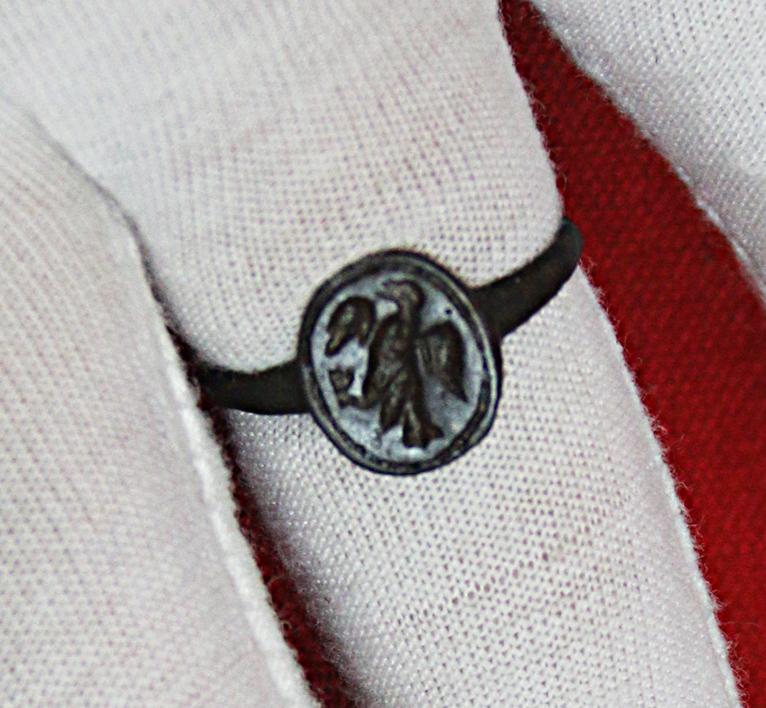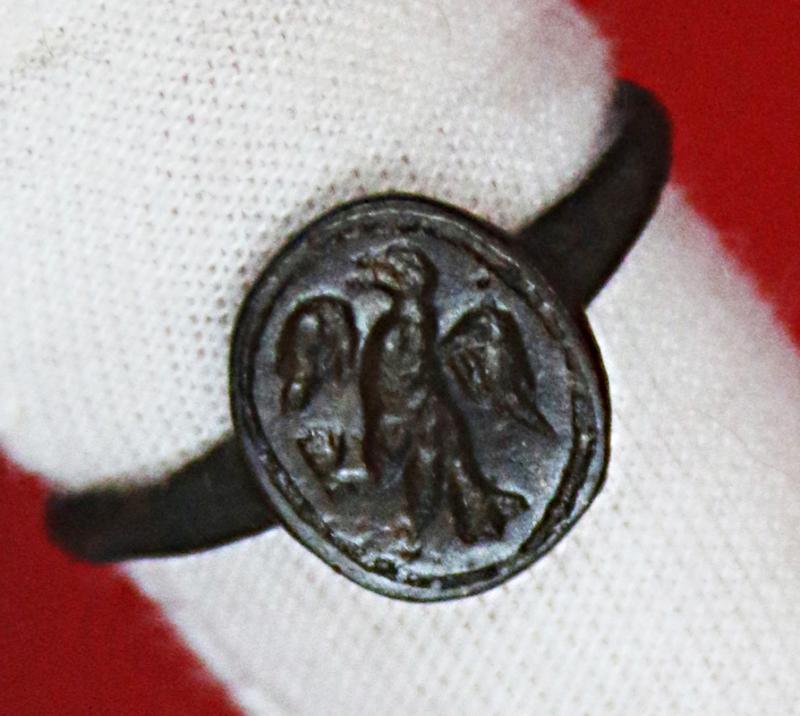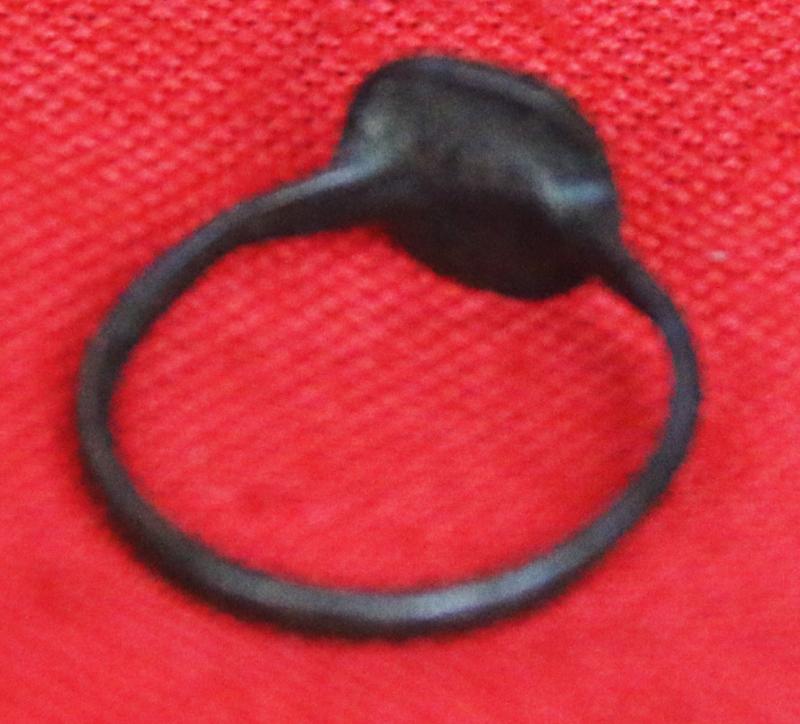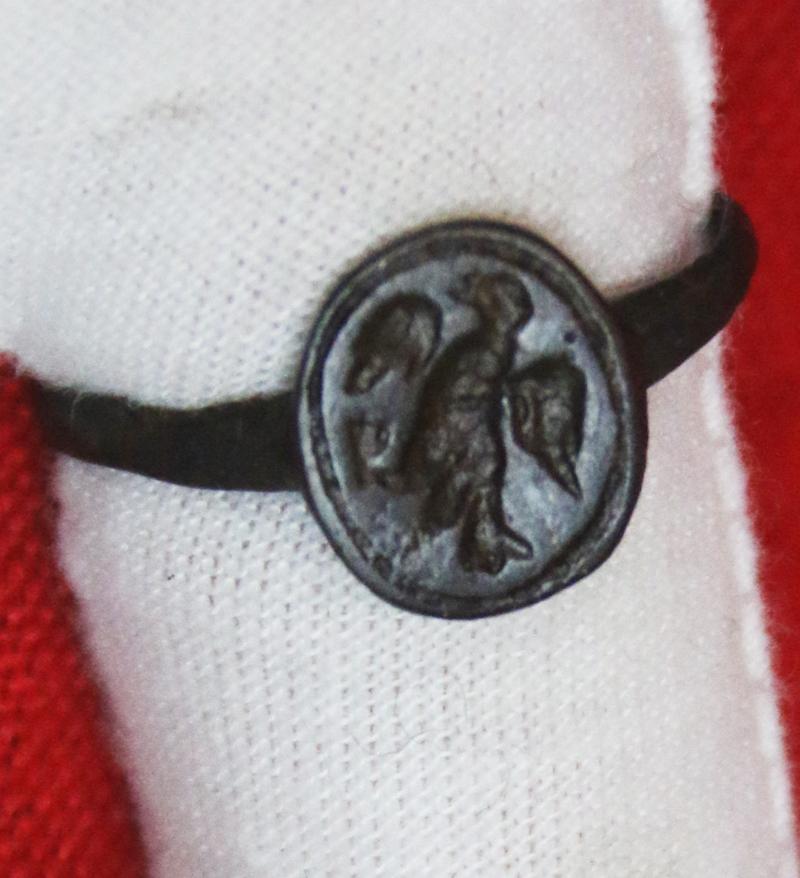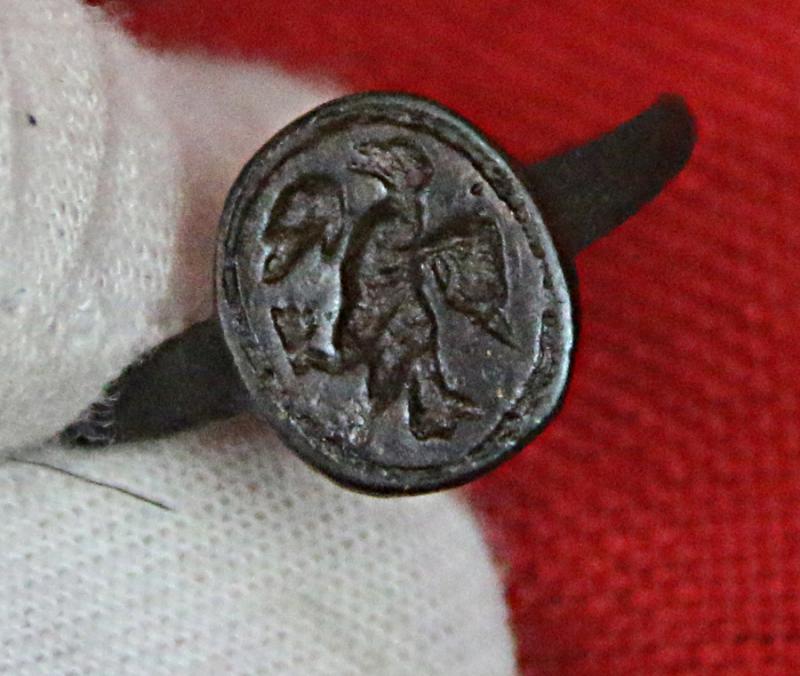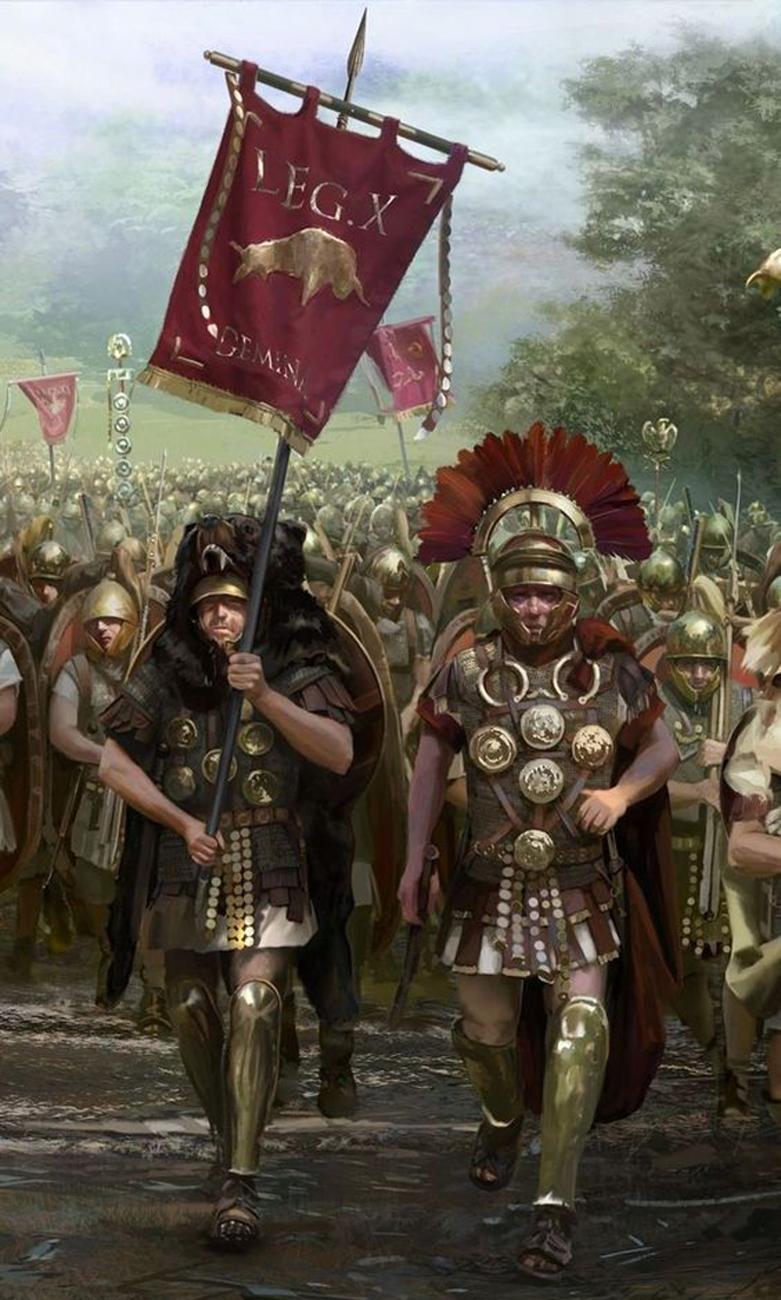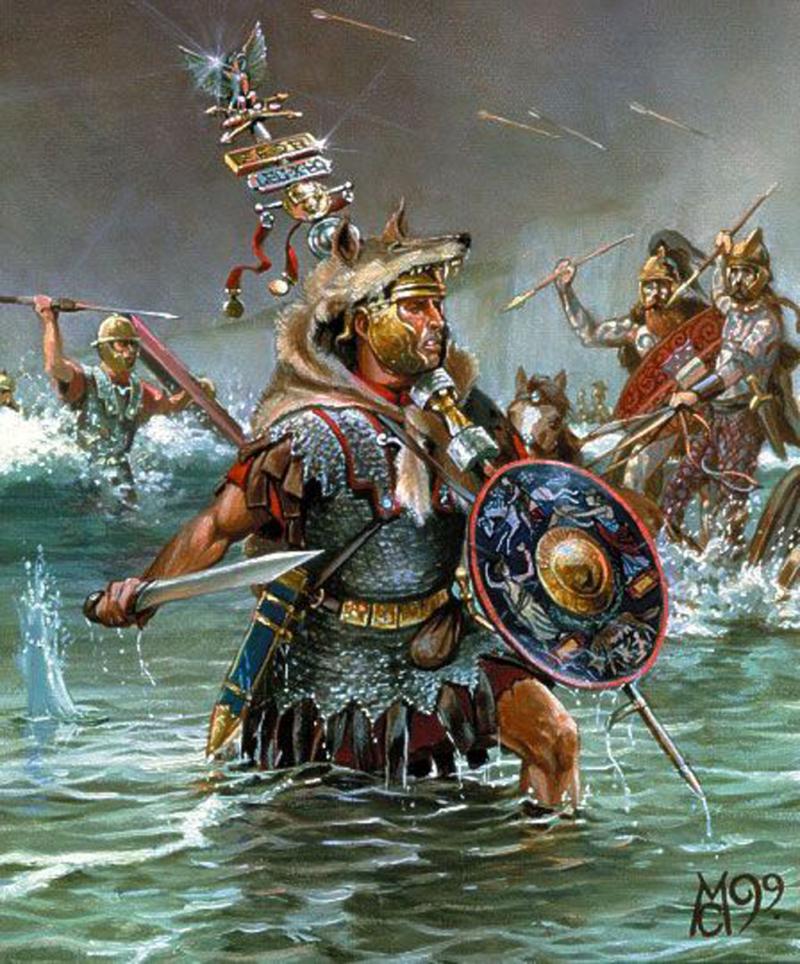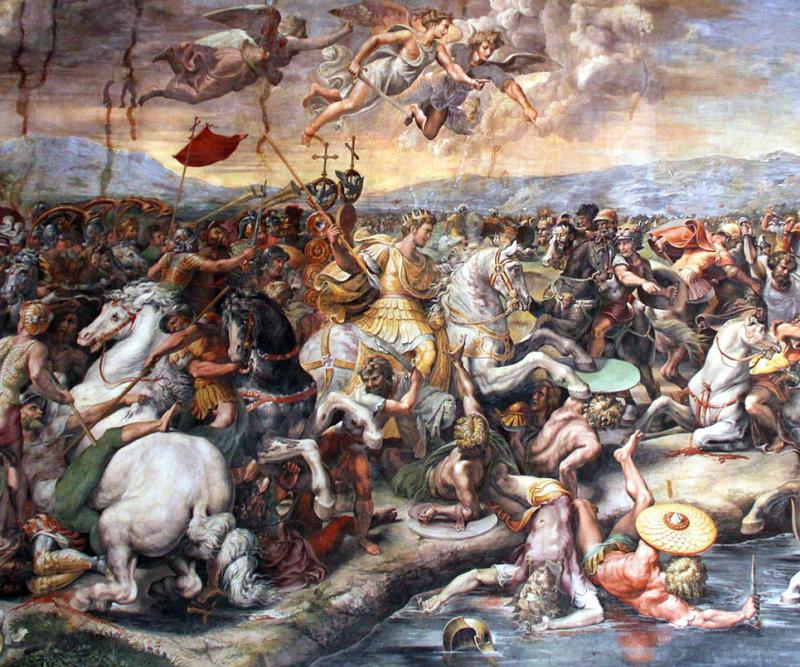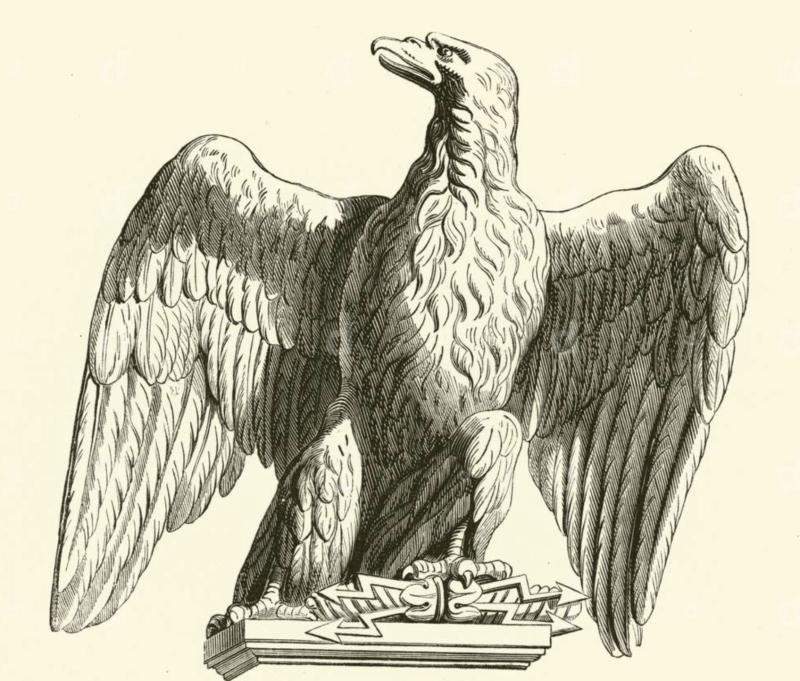Most Rare & Desirable, Status Ring, An Original Ancient Roman Bronze Ring Engraved With A Roman Legion’s Eagle Standard. An Image Of An Ancient Roman Legion's Standard Possibly For The Legion's Aquilfer {Standard Bearer} Circa 1700 Years Old
A fabulous Ancient Roman bronze Legionary's ring, from the era of Emperor Constantine The Great. The ovoid bezel is intaglio engraved with a Legionary Eagle, with its head turned to the viewers left (Aquila) with what appears to be the lightning bolt within its left claw. In superb, original, natural age patina of a rich dark bronze colour. The eagle was a powerful symbol to the Roman military. With each Roman legion a special eagle-bearer (aquilifer) had the honour of carrying the Legionary Eagle standard into battle and to guard its existence. Unusually, it is a comfortably wearable sized ring {which is somewhat rare due to original ancient Roman rings and armilla being usually smaller sized} In copper bronze with stunning, natural age patination.. By far the greatest percentage of rings from the Roman era were engraved in the stylised form, but a very small percent, perhaps less that .01 percent, were engraved in the realism form. This is one of those rare types of more realistic engravings. The wearing of the ring was the prerogative alone of Roman citizens or those of high rank and esteem, and legionaries. Some gladiators always aspired to but rarely achieved the ring likely due to their short life span within their violent craft. However, some did achieve such great success and were rewarded with riches, freedom and the right to wear the traditional Roman bronze status ring.
The decisive moment in the civil war of 312 ad came when Constantine I defeats his rival’s armies at the Battle of Turin – Constantine I also defeats forces loyal to Maxentius. At the Battle of Verona – Constantine I defeats more forces loyal to Maxentius. An on the 28 October – Battle of Milvian Bridge – Constantine I defeats Maxentius and takes control of Italy. Constantine was now in full control of the Roman West. But, more importantly, the victory over Maxentius marked a crucial threshold in the Roman Empire’s history. Apparently, prior to the battle, Constantine saw a cross in the sky and was told: “In this sign shall you conquer.” Encouraged by the vision, Constantine ordered his troops to paint their shield with the chi-rho emblem (initials symbolizing Christ). The Arch of Constantine, built to commemorate the victory over Maxentius, still stands in the centre of Rome.
The eagle was a powerful symbol to the Roman military. With each Roman legion a special eagle-bearer (aquilifer) had the honour of carrying the Legionary Eagle standard into battle and to guard its existence.
During a battle, the standard was carried by the aquilifer, or "eagle-bearer."
The standard was the mode of communication for generals and troops. A horn blast would instruct the soldiers to look to the emblem, then the aquilifer would wave, raise, or lower it to direct the troops on their next move.
The bearer was also tasked with guarding the standard. In terms of rank, aquilifers fell just underneath centurions. Within the legion, they received higher pay and better rations than the typical soldier.
The standard served as a symbol to place the legion as a collective above the individual. Losing a standard was emotionally devastating because of its intense symbolism. When one was lost in battle, the surviving legionaries were left in shame for failing their fallen brothers in arms. The group promptly disbanded and members devoted themselves to reacquiring the lost icon.
Standards often included an image of the reigning emperor or his name beneath the eagle, adding to the importance of the symbol. In many instances, the eagle on the standard was perched above an orb, signifying Rome's dominion over the entire world.
Subdivisions of legions each carried a smaller standard that identified their group number or name. These were used to quickly assemble the components of the legion when mobilizing for battle.
Some of the most famous standards in Roman history were the ones lost at the Battle of Teutoburg Forest in 9 AD. During a long campaign to conquer Germania, the tribes lured three legions into the forest and launched a guerilla warfare campaign, slaughtering the Roman soldiers.
In 16 AD, General Germanicus led his Roman troops into Germania to seize the lost standards, crossing borders established by Augustus.
Eagles played a central role in Roman life and culture, right from the society's inception.
The aquila, or eagle, is one the most enduring symbols of Roman civilization.
While different animals and mythological creatures served as meaningful signifiers throughout the Republic and Imperial eras, the eagle continuously symbolized power and authority.
In the city's founding myth, the brothers Romulus and Remus agreed to settle their dispute over where to build their kingdom by letting the gods decide. Remus spotted six eagles and Romulus later spotted twelve of the birds.
The eagle was considered majestic and transcendent, to the point that live birds were often caged on emperors' funeral pyres. Once they broke free and flew skyward, the Romans considered it a manifestation of the deceased emperor's transition to godhood.
Ancient Romans esteemed the eagle and adopted it as a symbol of victory. Pliny the Elder wrote extensively on eagles, noting that they possessed excellent eyesight and were skilled parents.
Symbolically, he claimed eagles were the only creature immune to lightning strikes, underscoring their divinity. Up to modernity, eagles are depicted with lightning bolts clutched in their talons.
The earliest standard used by the Roman army was a bundle of straw affixed to a tall staff. Over time, the Romans began using emblems of eagles, wolves, minotaurs, horses, and boars.
Following a crushing defeat in 105 BC at the Battle of Arausio during the Cimbrian War, the Romans completed a self-assessment. The consul Gaius Marius led a reorganization of the military structure. Marius' reforms transformed the Roman legions from a loose militia into a professional fighting force.
As part of the restructure, he declared the eagle as the military's standard and retired the other four creatures mentioned above. Putting the emphasis on the eagle was meant to place its central qualities, bravery and power, at the forefront of the army's identity.
From the mid-Republican era onwards, the standard was a bronze or silver Aquila with spread wings.
Emperor Constantine the Great
Emperor Constantius died in York, England. The system of succession at the time demanded that another Caesar should become emperor but the soldiers in York immediately proclaimed Constantine their leader. It proved to be a pivotal moment in history. He is known as Constantine the Great for very good reasons.
After nearly 80 years, and three generations of political fragmentation, Constantine united the whole of the Roman Empire under one ruler. By 324 he had extended his power and was sole emperor, restoring stability and security to the Roman world.
Constantine also abandoned Rome as the most important city in the empire, building a new capital modestly named Constantinople (now Istanbul). In the next two centuries, Rome and Italy became vulnerable to barbarian invasions. The much more easily defensible Constantinople lasted for another thousand years.
Finally, and perhaps most famously, Constantine’s strong support for Christianity had an incalculable impact on European history. He is said to have been converted to the faith in AD 312, although this has not been corroborated.
At the time only around ten per cent of the Roman empire’s population was Christian. The majority of the ruling elite worshipped the old gods of Rome. Constantine was the first emperor to allow Christians to worship freely, helping to unite and promote the faith. He went on to instigate the celebration of the birth of Christ we call Christmas.
One image in the gallery is of The Battle of the Milvian Bridge that took place between the Roman Emperors Constantine I and Maxentius on 28 October AD 312. It takes its name from the Milvian Bridge, an important route over the Tiber. Constantine won the battle and started on the path that led him to end the Tetrarchy and become the sole ruler of the Roman Empire. Maxentius drowned in the Tiber during the battle; his body was later taken from the river and decapitated, and his head was paraded through the streets of Rome on the day following the battle before being taken to Africa.
*Note behind the mounted figure of emperor Contantine is the emperor's legion's eagle standard, held aloft by his aquilfer.
Outside diameter: 22mm, UK size Q1/2, US 8.25 Signs of light wear consistent with age and use, yet still wearable.
Code: 25475
995.00 GBP

